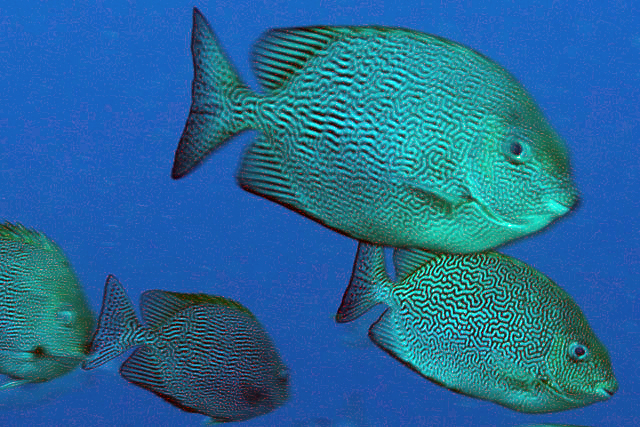| Siganidae (Rabbitfishes) |
| 45 cm TL (male/unsexed); max.weight: 2,393.0 g |
|
reef-associated; brackish; marine; depth range 0 - 20 m |
| Indo-West Pacific: India, Sri Lanka, Andaman Islands, Thailand, Malaysia, Singapore, Indonesia, Philippines, Belau [=Palau], Guam, New Guinea, Solomon Islands, Fiji, Vanuatu, ?New Caledonia, ?Western Australia, ?Pohnpei, Caroline Islands, ?Ebon Island and Marshall Islands. |
|
Dorsal spines (total): 13-13; Dorsal soft rays (total): 10-10; Anal spines: 7-7; Anal soft rays: 9-9; Vertebrae: 13-13. Body bluish white; head brown to brownish or golden yellow with irregular blue lines. Preopercular angle 91°-102°; strong overlapping scales cover cheeks; midline of thorax scaled, not pelvic ridges. Anterior nostril with low flange, broadened slightly posteriorly. Spines stout, blunt or pungent, and venomous. |
| Juveniles live among mangroves then move out to lagoon and coastal reefs as they mature. Forms schools. Feeds on algae growing on seagrasses, mangrove roots and rocks. Adults congregate inshore in groups of several hundreds to spawn in summer. Spawning is by pairs; sticky eggs laid on the bottom. Its very high quality flesh commands premium prices (Ref. 9813). Adults on coastal reefs, subject to strong currents (Ref. 48637). This species can tolerate very low salinities (2 ppt) and temperatures up to 38 C (Ref. 37816). |
|
Least Concern (LC); Date assessed: 25 August 2011 Ref. (130435)
|
| venomous |
Source and more info: www.fishbase.org. For personal, classroom, and other internal use only. Not for publication.
